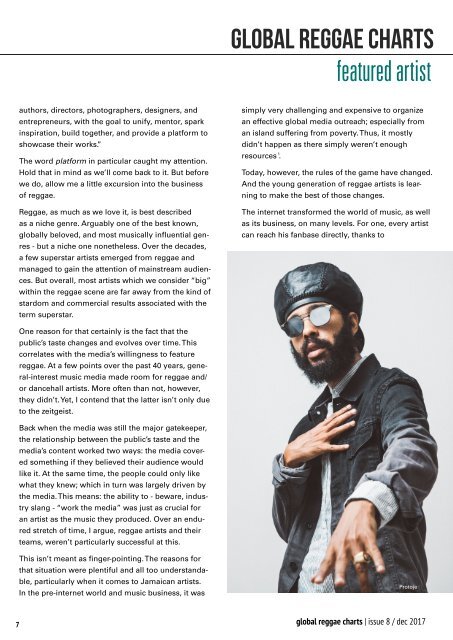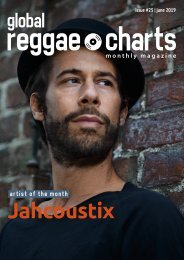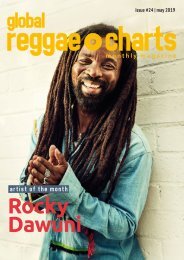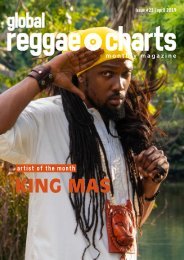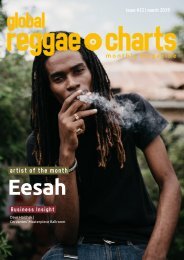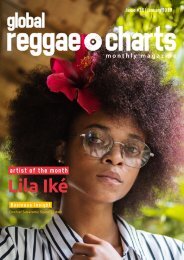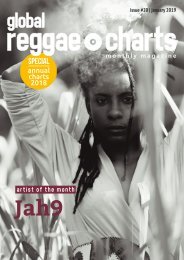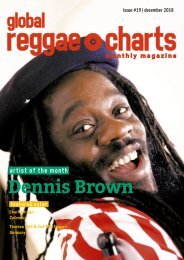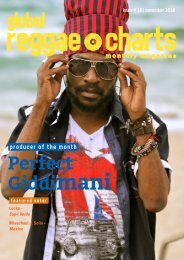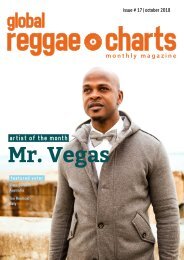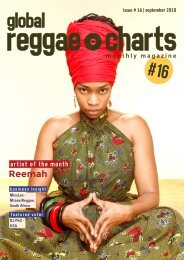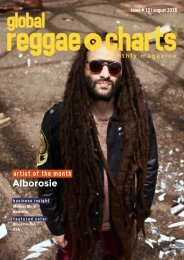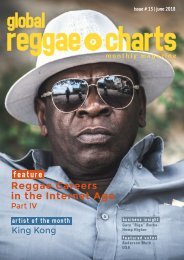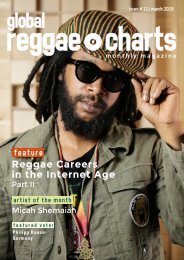Global Reggae Charts - Issue #8 / December 2017
Inside you can find the latest reggae album and single charts based on votes by radio DJs and music directors from around the world.
Inside you can find the latest reggae album and single charts based on votes by radio DJs and music directors from around the world.
You also want an ePaper? Increase the reach of your titles
YUMPU automatically turns print PDFs into web optimized ePapers that Google loves.
global reggae charts<br />
featured artist<br />
authors, directors, photographers, designers, and<br />
entrepreneurs, with the goal to unify, mentor, spark<br />
inspiration, build together, and provide a platform to<br />
showcase their works.”<br />
The word platform in particular caught my attention.<br />
Hold that in mind as we’ll come back to it. But before<br />
we do, allow me a little excursion into the business<br />
of reggae.<br />
<strong>Reggae</strong>, as much as we love it, is best described<br />
as a niche genre. Arguably one of the best known,<br />
globally beloved, and most musically influential genres<br />
- but a niche one nonetheless. Over the decades,<br />
a few superstar artists emerged from reggae and<br />
managed to gain the attention of mainstream audiences.<br />
But overall, most artists which we consider “big”<br />
within the reggae scene are far away from the kind of<br />
stardom and commercial results associated with the<br />
term superstar.<br />
simply very challenging and expensive to organize<br />
an effective global media outreach; especially from<br />
an island suffering from poverty. Thus, it mostly<br />
didn’t happen as there simply weren’t enough<br />
1<br />
resources .<br />
Today, however, the rules of the game have changed.<br />
And the young generation of reggae artists is learning<br />
to make the best of those changes.<br />
The internet transformed the world of music, as well<br />
as its business, on many levels. For one, every artist<br />
can reach his fanbase directly, thanks to<br />
One reason for that certainly is the fact that the<br />
public’s taste changes and evolves over time. This<br />
correlates with the media’s willingness to feature<br />
reggae. At a few points over the past 40 years, general-interest<br />
music media made room for reggae and/<br />
or dancehall artists. More often than not, however,<br />
they didn’t. Yet, I contend that the latter isn’t only due<br />
to the zeitgeist.<br />
Back when the media was still the major gatekeeper,<br />
the relationship between the public’s taste and the<br />
media’s content worked two ways: the media covered<br />
something if they believed their audience would<br />
like it. At the same time, the people could only like<br />
what they knew; which in turn was largely driven by<br />
the media. This means: the ability to - beware, industry<br />
slang - “work the media” was just as crucial for<br />
an artist as the music they produced. Over an endured<br />
stretch of time, I argue, reggae artists and their<br />
teams, weren’t particularly successful at this.<br />
This isn’t meant as finger-pointing. The reasons for<br />
that situation were plentiful and all too understandable,<br />
particularly when it comes to Jamaican artists.<br />
In the pre-internet world and music business, it was<br />
Protoje<br />
7<br />
global reggae charts | issue 8 / dec <strong>2017</strong>


